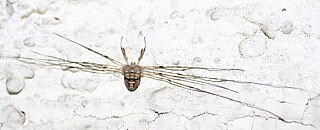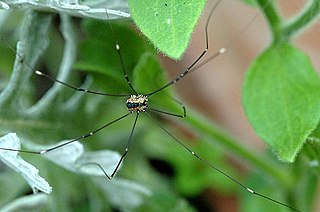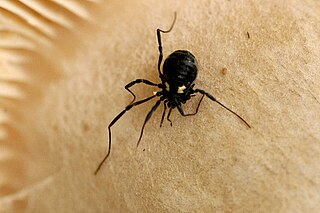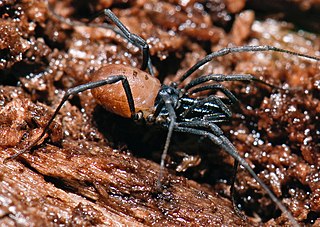
The Opiliones are an order of arachnids colloquially known as harvestmen, harvesters, harvest spiders, or daddy longlegs. As of April 2017, over 6,650 species of harvestmen have been discovered worldwide, although the total number of extant species may exceed 10,000. The order Opiliones includes five suborders: Cyphophthalmi, Eupnoi, Dyspnoi, Laniatores, and Tetrophthalmi, which were named in 2014.

Dicranopalpus is a genus of harvestmen with twelve known recent species. Three fossil species have been described, all from Baltic amber, but only D. ramiger is currently considered valid.

Dyspnoi is a suborder of harvestmen, currently comprising 43 extant genera and 356 extant species, although more species are expected to be described in the future. The eight families are currently grouped into three superfamilies: the Acropsopilionoidea, Ischyropsalidioidea, and Troguloidea.

The Sclerosomatidae are a family of harvestmen with about 1,300 known species. One former subfamily has been recently removed to form a new family, Globipedidae.

Leiobunum is a genus of the harvestman family Sclerosomatidae with more than 100 described species. Contrary to popular belief, they are not spiders, although they share a resemblance. They are arachnids, in the order Opiliones, harvestmen. Species in Leiobunum tend to have relatively long legs compared with other harvestmen, and some species are gregarious.

The Sironidae are a family of harvestmen with more than 30 described species.

Nipponopsalididae is a family of harvestmen with three described species in one genus, Nipponopsalis, which is found in East Asia.

Ischyropsalididae is a family of harvestmen with 35 described species in 3 genera, found in Europe and North America.

The Nemastomatidae are a family of harvestmen with about 170 described species in 16 recent genera. Several fossil species and genera are known.

The Dicranolasmatidae are a family of harvestmen with 16 described species in a single genus, Dicranolasma.

Epedanidae is a family of the harvestman infraorder Grassatores with about 200 described species. They are the sister group of the Gonyleptoidea.
Sandokanidae is a family of harvestmen in the suborder Laniatores, formerly referred to as Oncopodidae

The Cladonychiidae are a small family of harvestman with about 33 described species, within the suborder Laniatores.

Taracus is a genus of harvestman, or Opiliones, typically found living in limestone and lava caves in the United States. They grow to a size of 2.0–5.5 mm (0.08–0.22 in).

Acuclavella is a genus of thorn harvestmen in the family Ischyropsalididae, found in the Pacific Northwest. There are about seven described species in Acuclavella.

Taracidae is a family of harvestmen in the order Opiliones. There are 4 genera and 23 described species in Taracidae.

Ortholasmatinae is a subfamily of harvestmen with 27 described species in 7 genera.

Nemastomatinae is a subfamily of harvestmen with 123 described species in 18 genera.

Ischyropsalidoidea is a superfamily of harvestmen with 9 genera, found in Europe and North America.















